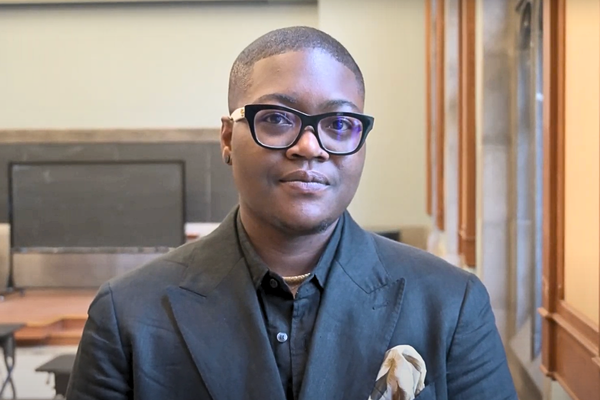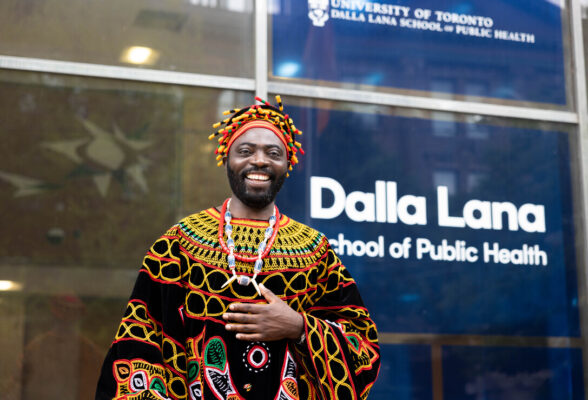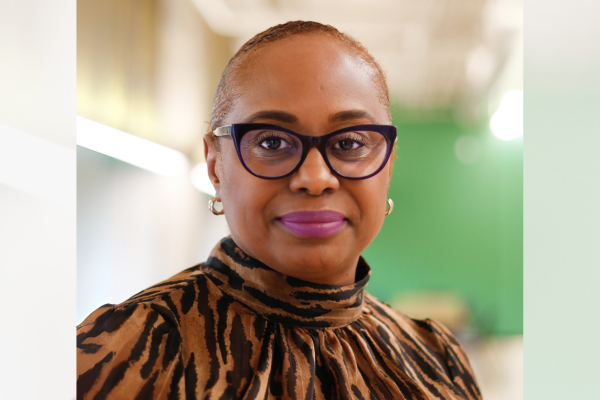Collaboratory for Black Poiēsis brings scholars, artists and archivists together for a deeper understanding of Black life


Rebuilding the traditional structures of a classroom is at the root of SA Smythe’s teaching philosophy.
For Smythe, an assistant professor of Black Studies and the Archive at the Faculty of Information, standing in front of a lecture hall comes with the responsibility to open the room so that everyone can share their insights about the topic at hand.
The approach is the foundation of the Collaboratory for Black Poiēsis (CBP), a mixed-methods research lab and creative workshop atelier dedicated to the multidisciplinary study of Black life, cultural technologies, and the arts.
“Black studies being a necessarily interdisciplinary and interdependent project, the CBP is arranged as a collaborative space where we think across differences about the technologies required for the living and thriving of Black people,” says Smythe, director of the CBP.
“We’re also thinking about how to sustain intellectual methods, cultural tools, and aesthetic practices that will get us there.”
The Collaboratory for Black Poiēsis was first established in 2022, upon Smythe’s arrival to the University of Toronto. With its public launch in October 2023 at the Faculty of Information, the CBP is redefining traditional approaches to critical inquiry and research as an arts co-working hub, archival nexus and creative studio. It emphasizes collaborations with transnational cultural workers, scholars, activists and community members to provide a deeper understanding of Black intellectual and creative traditions.
In classroom workshops, for example, students may create a collage, curate a playlist that accompanies themes from the syllabus, develop a performance or write a poem, rather than only write an essay. CBP researchers may also teach one another how to professionally archive treasured family recipes for future generations. This allows students to embody what they are learning – and makes it accessible to others.
“Despite discipline, beyond discipline, working together to create, to contemplate, to reflect on and to curate the conditions for Black life is for me what Black poiēsis encompasses,” Smythe says.
“I like to reach students in this space of what seems like an absence to show that through creative capacity, aesthetic formation and collaboration – fundamentally building collectivism – we can attend closely to some of these stories.”
Reimagining the archive
For Anu Makinde, music was often a main source of self-exploration as a Nigerian-Canadian.
Now, Makinde is documenting how Afrobeats and the Yoruba language form placemaking in Canada. The final project, still in development, will take form as a creative piece to make it accessible beyond the academy.
“Being in a digital world, the information that we consume is structured to make us relate to an image, or in my case, music, more than words,” says Makinde, a master’s student in the department of geography and planning.
“I want my final research output to be an educational source for the Black diaspora in Toronto whose lives are directly influenced by Afrobeats.”
Makinde’s project will apply a decolonial and Black feminist lens to examine archival practices and encourage audiences to consider how Black life is represented and preserved. Reimagining the archive as a source to build solidarity with racialized communities, she is guided by theories taught in the course “Black Studies and the Archive,” which Smythe taught in the winter of 2023. Cultural theory and Black geographies are applied in the course to collectively reconstruct historical narratives.
“What is it that you care about and how does that related to Black life, Black study, and Black aesthetic practive?”
– SA Smythe
To gain a deeper understanding of archival practices and Black life in Canada, Makinde and Alexis Fairclough-Dick, the CBP’s inaugural undergraduate research fellow, visited the Archives of Ontario to sort through the Globe & Mail Fonds – a repository of more than two million photographs – and the Mary Ann Shadd Cary fonds, which consist of letters received and written from 1851 to 1889 by Shadd Cary, the first Black female newspaper publisher in Canada.
Their archival research culminated in an art showcase at the CBPs symposium in May, where the photography of the Globe & Mail Fonds was positioned in relation to the personal writings of Shadd Cary to visually reconsider Canadian history.
Anu’s current focus is to understand how systems of knowledge solidify definitions like citizen, Blackness and culture in relation to each other in a place.
Meanwhile, Fairclough-Dick is producing a multimedia project to explore gender roles impressed upon West Indian women in the 1960s to 1970s. Melissa Vincent, the CBP’s lead research fellow for 2023-24, is a music journalist completing a master’s at the Faculty of Information, whose work explores equity, intimacy, and community formation as it relates to music, technology, and culture.
A sustainable and thriving research space for Black life
This spring, the CBP hosted its inaugural symposium, Calling the Conjurers: An Otherwise Symposium for Technologies of Black Life & Study. The CBP partnered with Logic(s), the first queer Black and Asian-led magazine dedicated to technology and culture in the U.S., in addition to Canada’s Black Curator’s Forum, and the Jackman Humanities Institute, the Black Research Network, and the Indigenous-led Technoscience Research Unit at U of T, among other contributors. Together, they brought Black artists, technologists, architects, community educators, and Black representatives and leaders from GLAM institutions (galleries, libraries, archives, and museums), arts incubators and universities from across North America, Africa, Europe and the Caribbean to host creative workshops and industry-specific networking events. The four-day event was supported by the Jackman Humanities Institute and the Black Research Network.
In late 2023, the CBP also began hosting [magnitude+bond], a multimedia reading group named after the last lines of a poem by Black American poet Gwendolyn Brooks, where participants shared music and other media in response to creative writing prompts as they read and interpreted Octavia Butler’s Patternist Series.
Ultimately, Smythe’s goal for the CBP is to ensure there is a sustainable and thriving space for research about Black life in the Faculty of Information and beyond. Looking ahead, Smythe will continue to build upon working relationships across industries and partners established during the CBP’s first two years and invites more potential collaborators—in particular students and community researchers and creative incubators—to join.
“Fundamentally, there is this exciting question mark of, ‘What does [the CBP] do?’” Smythe says. “Well, what do you want to do? What is it that you care about and how does that relate to Black life, Black study and Black aesthetic practice?”







